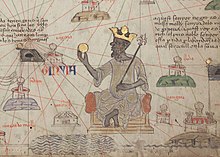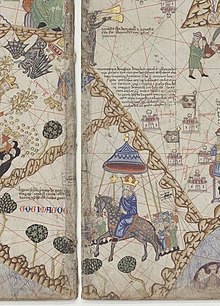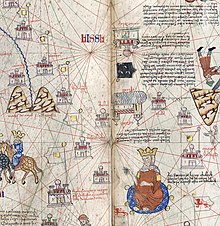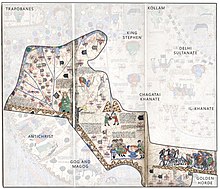利用者:デザート/カタルーニャ地図
| カタルーニャ図 | |
|---|---|
| Atles català | |
 地図のうち、レヴァントの描写 | |
| 材質 | 羊皮紙 |
| 高さ | 0.65 m |
| 幅 | 3m |
| 文字 | ラテン文字 |
| 製作 | アブラハム クレスク |
| 時代/文化 | 中世 |
| 発見 | 1380年 |
| 所蔵 | フランス国立図書館 |
カタルーニャ図(カタルーニャず、カタルーニャ語: Atles català 発音 [ˈatləs kətəˈla]、仏: Atlas catalan、英: Catalan Atlas)とは、1375年前後に作成された中世の世界地図(マッパ・ムンディ)である[1][2]。本作は、パルマ出身のユダヤ人アブラハム・クレスクとその息子ジェフダ・クレスクによって作成されたと伝わる。
本作は中世カタルーニャ語の重要文献であり[3][4]、「中世の地図製作の頂点」と称えられている[4]。
概要
[編集]この記事には独自研究が含まれているおそれがあります。 |

六枚の葉の内、最初の二枚にはカタルーニャ語で宇宙誌や占星術、天文学に関する文言が挿絵付きで並ぶ。内容は、地球の形や欧州・北阿の支配者や文物などについてである。また、船員向けに潮の干満や夜間の時刻の見方などの言及もみられる[5]。
残りの四枚は実際の地図になっており、イェルサレムを中心に2枚は東洋、2枚は西洋を描く。地図だけでも1.3m2の大きさがある。十字架で示されたキリスト教徒の都市、ドームで示されたムスリムやそれ以外の都市など、多くの都市が記されており、都市ごとの忠誠が旗を以て表されている。重要な港市は赤字で、その他の港市は黒字で書かれている。挿絵や説明は紙面の端に集中しており、平置きにして眺めることを想定している[6]。
特に東洋についての記述には、中世のマッパ・ムンディと当時の紀行文、例えばマルコ・ポーロの所謂『東方見聞録』やマンデヴィルの『東方旅行記』をはじめ、数多くの東洋の宗教についての記述があり、南アジアや東アジアの都市が確認できる[7]。
一方西洋の地図は現代の羅針儀海図に近く、ここに描かれた羅針図は確認できる限り最古のものである[4]。
描かれたもの
[編集]マリ帝国
[編集]
マリ帝国とそのマンサであるマンサ・ムーサの栄光が記されている。
この黒人の領主はマンサ・ムーサ、ジネーバ (ガーナ) の土地の統治者である。この王は、ジネーバの大地から掘り出される黄金のため、最も裕福で高貴なるものである。—カタルーニャ地図・キャプション、[8]
インド
[編集]
南アジアは、その西部が正確に描写されており、一部正確な地名がある[9][10]。北インドの有力な政権であったデリー・スルタン朝とそのスルタンが描かれ、都市には王朝の旗が掲げられている。
「ここに偉大なスルタンがある。スルタンは 700 頭の象と 10 万人の騎兵を従え、数えきれないほどの歩兵を指揮している。スルタンの国には金や宝石が潤沢である。」—カタルーニャ地図・キャプション、[11]


中央部には、伝説的なヤーダヴァ朝の都であるディオギルが見える。ディオギルの街には奇妙な旗![]() が掲げられていて、沿岸部の都市にはデリー・スルタン朝の旗が見える[12][13]。ディオギルは最終的にデリー・スルタン朝のアラー・ウッディーン・ハルジーの手に落ちた[14]。
が掲げられていて、沿岸部の都市にはデリー・スルタン朝の旗が見える[12][13]。ディオギルは最終的にデリー・スルタン朝のアラー・ウッディーン・ハルジーの手に落ちた[14]。
「これらの船はニチと名付けられ、深さ60キュビト、長さ34キュビトであることを知っておくように。ほとんどの船に4本以上の帆柱があり、10 本のものさえある。帆は葦とヤシの葉で作られる。」—カタルーニャ地図、キャプション、[15]
南インドの先端には、十字旗を掲げた「コロンボの王」が描写されている。この地域には8世紀にはすでにトマス派の存在が認められており、14世紀以降のジョルダン・カタラによる布教の記録も相まって、この人物はキリスト教徒だと見られている[16]。
「この地はキリスト者コラムの王が統治している。」—カタルーニャ地図・キャプション、[11]
1329年からコロンボに赴いた宣教師ジョルダンは、『驚異の書』(羅: Mirabilia descripta, 1340)を著したが、おそらくこれが地図に記載されたコロンボの情報源だと思われる[17]。ジョルダンはインドにおけるトマス派以前のキリスト教徒の存在を示唆した[18]。
フレグ・ウルス
[編集]

フレグ・ウルスは、首都タブリーズにちなんでタウリスの王(カタルーニャ語: Rey del tauris)と紹介されている[20][10]。
このキャプションは、バビロンという都市にのみ関連している:
ここにナブコノドソルが住んでいた大バビロニアがあり、そこは今日バルダカ(Baldaca )と呼ばれている。 多くの香辛料やその他の高貴な産物がインド諸島からこの都市にもたらされ、それらはシリア、特にダマスカスの都市で流通していることを知らしめよう。—[15]

 ), sailing the Indian Ocean towards the coast of India under the control of the Delhi Sultanate (
), sailing the Indian Ocean towards the coast of India under the control of the Delhi Sultanate ( ).[21]
).[21]Over him appears a city within a sphere, with the following caption, mentioning the Persian city of Shiraz and Ptolemy:
Two ships with flags of the Ilkhanate appears on the India Ocean, sailing to and from the Indian coast, where appear flags of the Delhi Sultanate. The label attached to one of the ships reads:
Golden Horde
[編集]
The Mongol polity of the Golden Horde is accurately depicted north of the Caspian Sea. The ruler named Jani Beg has been identified in this representation, being mentioned as "Jambech senyor de Sarra", and the flag of the Golden Horde also appears (![]() ).[23] The caption to the right reads:
).[23] The caption to the right reads:


 , dated 1273–1275.
, dated 1273–1275.Here resides the emperor of this northern region whose empire starts in the province of Bulgaria and ends at the city of Organcio. The sovereign is named Jambech, Lord of the Sarra. [15]
The symbolism of the Golden Horde flag depicted by the Catalan Atlas (![]() ) is fairly similar to the type of tamgha symbols (such as
) is fairly similar to the type of tamgha symbols (such as ![]() ) actually found on the coinage of the Golden Horde.[24][25] Such symbols were used until the time of Jani Beg, but essentially disappear thereafter.[26]
) actually found on the coinage of the Golden Horde.[24][25] Such symbols were used until the time of Jani Beg, but essentially disappear thereafter.[26]
The text to the left reads:
Let it be known that those that wish to cross this desert stop and rest during a week in a city named Lop. Here, expeditions and their animals relax/enjoy themselves. After that, they procure what is needed for the next seven months of the journey, because in the desert one travels an entire day and night before reaching potable water; however, every day and a half, they can find plenty of it, enough for fifty or a hundred people or even more. And if it happens that a rider, tired by the journey, falls sleep or for any other reason he separates from his companions, he will often hear the voices of devils, similar to the voices of his companions, often calling him by his own name. In this way, the devils take him through the desert to a fro such that the traveler cannot find his companions. A thousand stories are known about this desert. [15]
Anatolia
[編集]
The Anatolian Beyliks, a group of Turkic principalities in Anatolia are also depicted, in the region labelled Turqhia (Turkey). The caption next to the seated ruler in Anatolia reads: Asia Minor also called Turkey, where there are many cities and castles.[27][28] Numerous Turkic principalities appear, with a variety of flags, but very little prominence is given to the Orthodox princes of the Byzantine Empire, although several Byzantine cities appear with the Byzantine imperial flag (![]() ), or Trebizond (
), or Trebizond (![]() ).[28] The Christian kingdom of Cilician Armenia appears heavily fortified within green walls, with its ports and flags (
).[28] The Christian kingdom of Cilician Armenia appears heavily fortified within green walls, with its ports and flags (![]() ,
, ![]() ) clearly visible.[29][30]
) clearly visible.[29][30]
Gog and Magog
[編集]
The land of "Gog i Magog" (Gog and Magog) appear in the top right corner. Its king is mounted on a horse, followed by a procession. Next to it appears Alexander's Gate, showing Alexander, the Antichrist, and mechanical trumpeters.
Chagatai Khanate
[編集]
The Khan Kebek, Mongol ruler of the Chagatai Khanate is depicted with the following caption:
His cities appear with the Chagatai flag (![]() ).[33]
).[33]
Cathay (China)
[編集]
 ) appears on all the territory.
) appears on all the territory.The cities of Cathay, at that time the Empire of the Great Khan (Yuan China), are shown raising a flag with three red crescent moons (![]() ). The flag is seen all over eastern Asian cities in the Catalan Atlas.[36]
). The flag is seen all over eastern Asian cities in the Catalan Atlas.[36]
Kubilai Khan appears enthroned and wearing a green coat, with the following caption:
The most powerful prince of the Tartars is named Holubeim [Kubilay Khan], that means Great Khan. This emperor is richer than any other emperor in the world. This emperor is protected by twelve thousand horsemen with their four captains that stay at the court three months of the year.[32]
Antichrist
[編集]
The Antichrist appears beyond the Great Wall of China, next to the territory of Gog and Magog. The label reads:
Antichrist. He will be raised in Goraym of Galilea, and at the age of thirty he will start to preach in Jerusalem; contrary to the truth, he will proclaim that he is Christ, the living son of God. It is said that he will rebuild the Temple.[37]
In the top corner is Alexander the Great ("Allexandri") fighting the devil.
Beyond is the ocean ("Mare Oceanis"), without mention of Japan.
Gallery
[編集]-
Modern copy of western half
-
A modern reproduction of the Catalan Atlas depicting the eastern Mediterranean region.
-
Reproduction of the first leaf
-
Reproduction of the second leaf
See also
[編集]References
[編集]- ^ Ferandez-Armesto, F.F.R. (1995). The European opportunity. Aldershot, Great Britain ; Brookfield, Vt. : Variorum. p. 291. ISBN 978-0-86078-501-9. "The Catalan Atlas is conventionally attributed to 1375, because that year is used as the starting-point for the computation of the Golden Number, but 1376 and 1377 are also mentioned in its accompanying texts; it conforms closely to the description of such an atlas in the French royal library catalogue, dated 1380 [...] The Catalan Atlas can be assigned with some confidence to the late 1370s or the early 1380s."
- ^ The date "1375" is mentioned in several places in the map: Gunn, Geoffrey C. (15 October 2018) (英語). Overcoming Ptolemy: The Revelation of an Asian World Region. Rowman & Littlefield. p. 67. ISBN 978-1-4985-9014-3
- ^ Cecil Roth (1940). The Jewish Contribution To Civilization. Harper. pp. 69–72. ISBN 9781443725231 2010年4月28日閲覧。
- ^ a b c Clayton J. Drees (2001). The Late Medieval Age of Crisis and Renewal, 1300–1500: A Biographical Dictionary (The Great Cultural Eras of the Western World). Greenwood. pp. 119–120. ISBN 0-313-30588-9
- ^ Edwin Castano. “Catalan World Atlas”. 9 Maps That Have Shaped The World. Martian Herald. 11 July 2019時点のオリジナルよりアーカイブ。11 July 2019閲覧。
- ^ Botton, Jerry (2014). Great Maps. DK Publishing. p. 62. ISBN 9786027244962 26 July 2018閲覧。
- ^ Dhani Irwanto (27 March 2019). Taprobana: Classical Knowledge of an Island in the Opposite-Earth. Indonesia Hydro Media. p. 15. ISBN 9781465435613 11 July 2019閲覧。
- ^ “The Cresques Project - Panel III”. www.cresquesproject.net. Template:Cite webの呼び出しエラー:引数 accessdate は必須です。
- ^ (英語) Cartography between Christian Europe and the Arabic-Islamic World, 1100-1500: Divergent Traditions. BRILL. (17 June 2021). p. 176. ISBN 978-90-04-44603-8
- ^ a b Gunn, Geoffrey C. (15 October 2018) (英語). Overcoming Ptolemy: The Revelation of an Asian World Region. Rowman & Littlefield. p. 68. ISBN 978-1-4985-9014-3
- ^ a b Liščák, Vladimír (2017). “Mapa mondi (Catalan Atlas of 1375), Majorcan cartographic school, and 14th century Asia”. International Cartographic Association 1: 5. Bibcode: 2018PrICA...1...69L. doi:10.5194/ica-proc-1-69-2018.
- ^ Antiquities from San Thomé and Mylapore. (1936). pp. 264–265
- ^ Kadoi, Yuka (2010). “On the Timurid flag”. Beiträge zur islamischen Kunst und Archäologie 2: 148. doi:10.29091/9783954909537/009. ""...helps identify another curious flag found in northern India – a brown or originally silver flag with a vertical black line – as the flag of the Delhi Sultanate (602-962/1206-1555).""
- ^ Beaujard, Philippe (2019). [978-1108424653 The worlds of the Indian Ocean : a global history : a revised and updated translation]. Cambridge University Press. p. Chapter 8. ISBN 978-1-108-42456-1. ""The sultan captured the Rajput fort of Chitor, in Rājasthān, and in 1310 he subjected most of the Deccan to his power. He took Devagiri – the capital of the Yādava – in 1307""
- ^ a b c d e “The Cresques Project - Panel V”. www.cresquesproject.net. Template:Cite webの呼び出しエラー:引数 accessdate は必須です。
- ^ Liščák, Vladimír (2017). “Mapa mondi (Catalan Atlas of 1375), Majorcan cartographic school, and 14th century Asia”. International Cartographic Association 1: 4–5. Bibcode: 2018PrICA...1...69L. doi:10.5194/ica-proc-1-69-2018.
- ^ Liščák, Vladimír (2017). “Mapa mondi (Catalan Atlas of 1375), Majorcan cartographic school, and 14th century Asia”. International Cartographic Association 1: 4–5. Bibcode: 2018PrICA...1...69L. doi:10.5194/ica-proc-1-69-2018.
- ^ Jordanus, Catalani; Yule, Henry; Parr, Charles McKew donor; Parr, Ruth (1863). Mirabilia descripta : the wonders of the East. London : Printed for the Hakluyt Society. p. 23, paragraph 31
- ^ Massing, Jean Michel; Albuquerque, Luís de; Brown, Jonathan; González, J. J. Martín (1 January 1991) (英語). Circa 1492: Art in the Age of Exploration. Yale University Press. p. 29. ISBN 978-0-300-05167-4
- ^ Massing, Jean Michel; Albuquerque, Luís de; Brown, Jonathan; González, J. J. Martín (1 January 1991) (英語). Circa 1492: Art in the Age of Exploration. Yale University Press. p. 29. ISBN 978-0-300-05167-4
- ^ Dang, Baohai; Rong, Xinjiang (9 November 2021) (中国語). Marco Polo and the Silk Road. Beijing Book Co. Inc.
- ^ Sapiats que aquestes naus són appellades Nichi e han ·LX· coldes de carena e hobren ·XXX·IIII· coldes e menys han encara de ·IIII· arbres fins en ·X· e les [lurs] veles són de canes e palma. Buchon, Jean Alexandre (2011). Notice D'un Atlas En Langue Catalane, Manuscrit de L'An 1375 Conservé Parmi Les Manuscrits de La Bibliothèque Royale Sous Le Numéro 6816, Fonds Ancien. p. 120. ISBN 978-1271741458
- ^ a b Massing, Jean Michel; Albuquerque, Luís de; Brown, Jonathan; González, J. J. Martín (1 January 1991) (英語). Circa 1492: Art in the Age of Exploration. Yale University Press. p. 29. ISBN 978-0-300-05167-4
- ^
 Coinage of Mengu-Timur. Bulghar mint. Dated AH 672 or 3 (AD 1273-1275)
Coinage of Mengu-Timur. Bulghar mint. Dated AH 672 or 3 (AD 1273-1275)
- ^ (英語) Asiatische Forschungen. O. Harrassowitz. (1982). p. 184. ISBN 978-3-447-02273-6. ""The tamga ( a sign of ownership or of belonging to a clan ) drawn on the flag can be seen on coins minted in Bulgar and Bilyar at the time of the early Golden Horde. (...) Besides the Catalan atlas of 1375 there is also a 50 x123 cm Catalan map preserved in Paris.""
- ^ FEDOROV-DAVYDOV, GERMAN A. (2003). “The Monetary System of The Golden Horde”. Paleograph Press: 349. ""Tamga in the form of a two-pointed prong was retained on the coins minted in Bolgar, Mokhsha and the Crimea up until the reign of Janibek, marking the disappearance of this image for the rest of the 14th century.""
- ^ a b “The Cresques Project - Panel IV”. www.cresquesproject.net. Template:Cite webの呼び出しエラー:引数 accessdate は必須です。
- ^ a b c Forêt, Philippe; Kaplony, Andreas (30 November 2008) (英語). The Journey of Maps and Images on the Silk Road. BRILL. p. 194. ISBN 978-90-474-2497-0
- ^ Massing, Jean Michel (1 January 1991) (英語). Circa 1492: Art in the Age of Exploration. Yale University Press. p. 27. ISBN 978-0-300-05167-4. ""The Cilician kingdom of Armenia Minor is more clearly indicated. Founded at the end of the twelfth century, it fell to the Turks in 1375""
- ^ Galichian, Rouben (2014). Historic Maps of Armenia - The Cartographic Heritage. Abridged and updated. BENNETT & BLOOM. p. 59
- ^ Açi senyoreya lo rey Chabech, seynior qui es dit del imperi de Medeia. Aquest esta en Emalech. in Buchon, Jean Alexandre (2011). Notice D'un Atlas En Langue Catalane, Manuscrit de L'An 1375 Conservé Parmi Les Manuscrits de La Bibliothèque Royale Sous Le Numéro 6816, Fonds Ancien. p. 135. ISBN 978-1271741458
- ^ a b c “The Cresques Project - Panel VI”. www.cresquesproject.net. Template:Cite webの呼び出しエラー:引数 accessdate は必須です。
- ^ Massing, Jean Michel (1 January 1991) (英語). Circa 1492: Art in the Age of Exploration. Yale University Press. p. 30. ISBN 978-0-300-05167-4
- ^ a b Buchon, Jean Alexandre (2011). Notice D'un Atlas En Langue Catalane, Manuscrit de L'An 1375 Conservé Parmi Les Manuscrits de La Bibliothèque Royale Sous Le Numéro 6816, Fonds Ancien. p. 131. ISBN 978-1271741458
- ^ Kadoi, Yuka (2010). “On the Timurid flag”. Beiträge zur islamischen Kunst und Archäologie 2: 144, 149. doi:10.29091/9783954909537/009.
- ^ Cavallo, Jo Ann (28 October 2013) (英語). The World Beyond Europe in the Romance Epics of Boiardo and Ariosto. University of Toronto Press. p. 32. ISBN 978-1-4426-6667-2
- ^ “Catalan Atlas. The Cresques Project - Panel VI”. www.cresquesproject.net. Template:Cite webの呼び出しエラー:引数 accessdate は必須です。
<references> で定義されている name "To the Ends of the Earth: 100 Maps that Change the World" の <ref> タグは、先行するテキスト内で使用されていません。Further reading
[編集]- Edson, Evelyn (2007). The World Map 1300-1492. Baltimore: Johns Hopkins University Press. pp. 74–86. ISBN 978-0801885891
External links
[編集]- Bibliothèque nationale de France – L'Atlas Catalan
- Complete transcription of the Catalan language text, and translation to French (1839): Buchon, Jean Alexandre (2011). Notice D'un Atlas En Langue Catalane, Manuscrit de L'An 1375 Conservé Parmi Les Manuscrits de La Bibliothèque Royale Sous Le Numéro 6816, Fonds Ancien. p. 135. ISBN 978-1271741458
- The Catalan Atlas [via Internet Archive]
- cresquesproject.net – translation of the works of Riera i Sans and Gabriel Llompart on the Jewish Majorcan Map-makers of the Late Middle Ages
- Abraham Cresques ? Atlas de cartes marines, dit [Atlas catalan], gallica.bnf.fr







